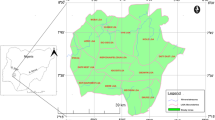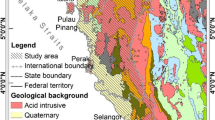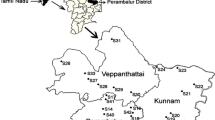Abstract
Measurements of ambient gamma radiation dose and radioactivity of soil and rocks samples have been carried out in 103 sites located in the region of Marrah mountain (western Sudan) using survey meters and gamma spectrometry techniques, respectively. The ambient dose varied from 0.05 to 0.25 µSv/h with mean value of 0.18 ± 0.05 (SD) µSv/h. At high altitudes (> 1500 m), relatively high values were observed (0.18–0.22 µSv/h). The levels of 238U, 232Th and 40K in soil–rocks were in the ranges 12–80, 12–66 and 120–937 Bq/kg with mean ± SD of (41 ± 6.9), (24 ± 12) and (540 ± 99) Bq/kg, respectively, equivalent to total gamma absorbed dose of 23–142 (66 ± 20) nGy/h. The ambient dose data were presented in cartography format, and correlation to geological maps was attempted. Surface map of the absorbed dose created using geostatistical kriging tools showed the spatial distribution of dose. Analyses showed that trends of high values were located in and around areas characterized by local flow and basaltic flow lithology, while the low values were observed at locations of basement rocks (granitic) in general. That was attributed to the differences in environmental conditions in various altitude and weathering processes. The highest readings (0.25 µSv/h and 142 nGy/h) were found in Deriba Complex Pumice air-fall deposits (younger explosive phase). Health risk was assessed by calculating annual effective dose for the inhabitants resulted in values range between 0.14 and 1.4 mSv/y (mean ± SD of 0.40 ± 0.12 mSv/y). The observed values of dose rates are comparable with some countries but higher than the worldwide average for outdoor annual affective dose of 0.07 mSv/y.






Similar content being viewed by others
References
Abd El-mageed AI, El-Kamel AH, Abbady A, Harb S, Youssef AMM, Saleh II (2011) Assessment of natural and anthropogenic radioactivity levels in rocks and soils in the environments of Juban town in Yemen. Radiat Phys Chem 80(6):710–715
Aliyu AS, Ramli TA (2015) The world’s high background natural radiation areas (HBNRAs) revisited: a broad overview of the dosimetric, epidemiological and radiobiological issues. Radiat Meas 73(2015):51–59
Alnour IA, Wagiran H, Ibrahim N, Laili Z, Omar M, Hamzah S, Idi Bello Y (2012) Natural radioactivity measurements in the granite rock of quarry sites, Johor Malaysia. Radiat Phys Chem 81(12):1842–1847
Al-Sulaiti H, Nasir T, AlMugren KS, Alkhomashi N, Al-Dahan N, Al-Dosari M, Bradley DA, Bukhari S, Matthews M, Regan PH, Santawamaitre T, Malain D, Habib A (2012) Determination of the natural radioactivity levels in north west of Dukhan, Qatar using high-resolution gamma-ray spectrometry. Appl Radiat Isot 70:1344–1350
Banzi FP, Msaki P, Makundi IN (2002) A survey of background radiation dose rates and radioactivity in Tanzania. Health Phys 82(1):80–86
Beamish D (2014) Environmental radioactivity in the UK: the airborne geophysical view of dose rate estimates. J Environ Radioact 138:249–263
Beretka J, Mathew PJ (1985) Natural radioactivity of Australian building materials, industrial wastes and by-products. Health Phys 48:87–95
Bezuidenhout J (2013) Measuring naturally occurring uranium in soil and minerals by analysing the 352 keV gamma-ray peak of 214Pb using a NaI(Tl)-detector. Appl Radiat Isot 80:1–6
do Rio MAP, Amaral ECS, Fernandes HM, Rochedo EPR (2002) Environmental radiological impact associated with non-uranium mining industries: a proposal for screening criteria. J Environ Radioact 59(1):1–17
El-Arabi AM, Abbady Adel GE, Hussein AS (2006) Gamma-ray measurements of natural radioactivity in sedimentary rocks from Egypt. Nucl Sci Tech 17(2):123–128
Idriss H, Salih I, Alaamer AS, Saleh A, Abdelgali MY (2016) Environmental-impact assessment of natural radioactivity around a traditional mining area in Al-Ibedia, Sudan. Arcives Environ Contam Toxicol 70(4):783–792
Jeevarenuka K, Sankaran PG, Hameed PS, Mathiyarasu R (2014) Evaluation of natural gamma radiation and absorbed gamma dose in soil and rocks of Perambalur district (Tamil Nadu, India). J Radioanal Nucl Chem 302:245–252
Keith LS, Faroon OM, Fowler BA (2015) Handbook on the toxicology of metals, 4th edn. Elsevier, pp. 1307–1345
Makweba M, Holm E (1993) The natural radioactivity of rock phosphates, phosphatic products and their environmental implications. Sci Total Environ 133(1–2):99–110
Malczewski D, Teper L, Dorda J (2004) Assessment of natural and anthropogenic radioactivity levels in rocks and soils in the environs of Swieradow Zdrojin Sudetes, Poland, by in situ gamma-ray spectrometry. J Environ Radioact 73:233–245
Sohrabi M (2013) World high background natural radiation areas: need to protect public from radiation exposure. Radiat Meas 50:166–171
Paschoa AS, Godoy JM (2002) The areas of high natural radioactivity and TENORM wastes. Int Congr Ser 1225:3–8
Pooya Hosseini SM, Dashtipour MR, Enferadi A, Orouji T (2015) Public exposure due to external gamma background radiation in boundary areas of Iran. J Environ Radioact 147:97–99
Popov L (2012) Method for determination of uranium isotopes in environmental samples by liquid–liquid extraction with triisooctylamine/xylene in hydrochloric media and alpha spectrometry. Appl Radiat Isot 70(10):2370–2376
Rafique M, Khan AR, Jabbar A, Rahman SU, Kazmi SJA, Nasir T, Arshed W, Matiullah (2014) Evaluation of radiation dose due to naturally occurring radionuclides in rock samples of different origins collected from Azad Kashmir. Russ Geol Geophys 55(9):1103–1112
Sahoo SK, Žunić ZS, Kritsananuwat R, Zagrodzki P, Bossew P, Veselinovic N, Mishra S, Yonehara H, Tokonami S (2015) Distribution of uranium, thorium and some stable trace and toxic elements in human hair and nails in Niška Banja Town, a high natural background radiation area of Serbia (Balkan region, South–East Europe). J Environ Radioact 145:66–77
Saïdou FO, Baechler SB, Moïse KN, Merlin N, Froidevaux P (2011) Natural radioactivity measurements and dose calculations to the public: case of the uranium-bearing region of Poli in Cameroon. Radiat Meas 46:254–260
Salih I, Pettersson HBL, Lund E, Siverturn Å (2002) Spatial correlation between radon (222Rn) in groundwater and bedrock uranium (238U): GIS and geostatistical analyses. J Spat Hydrol 2(2):1–10
Sam A, Holm E (1995) The natural radioactivity in phosphate deposits from Sudan. Sci Total Environ 162(2–3):173–178
Sartandel SJ, Jha SK, Bara SV, Tripathi RM, Puranik VD (2009) Spatial distribution of uranium and thorium in the surface soil around proposed uranium mining site at Lambapur and its vertical profile in the Nagarjuna Sagar Dam. J Environ Radioact 100(10):831–834
Selvasekarapandian S, Sivakumar R, Manikandan NM, Meenakshisundaram V, Raghunath VM, Gajendran V (2000) Natural radionuclide distribution in soils of Gudalore, India. Appl Radiat Isot 52:299–306
UNSCEAR (2000) Effects of atomic radiation to the general assembly. United Nations scientific committee on the effect of atomic radiation, New York
Yildiz N, Oto B, Turhan S, Ugur FA, Goren E (2014) Radionuclide determination and radioactivity evaluation of surface soil samples collected along the Erçek Lake basin in eastern Anatolia, Turkey. J Geochem Explor 146:34–39
Author information
Authors and Affiliations
Corresponding author
Rights and permissions
About this article
Cite this article
Abdalhamid, S., Salih, I. & Idriss, H. Gamma absorbed radiation dose in Marrah mountain series, western Sudan. Environ Earth Sci 76, 672 (2017). https://doi.org/10.1007/s12665-017-7009-7
Received:
Accepted:
Published:
DOI: https://doi.org/10.1007/s12665-017-7009-7




